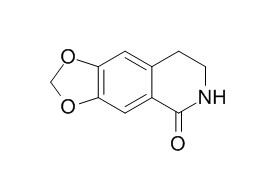Noroxyhydrastinine
Noroxyhydrastinine exhibits potent melanogenesis-inhibitory activities, it inhibits melanogenesis, at least in part, by inhibiting the expression of protein levels of tyrosinase, TRP-1, and TRP-2 in α-MSH-stimulated B16 melanoma cells.
Inquire / Order:
manager@chemfaces.com
Technical Inquiries:
service@chemfaces.com
Tel:
+86-27-84237783
Fax:
+86-27-84254680
Address:
1 Building, No. 83, CheCheng Rd., Wuhan Economic and Technological Development Zone, Wuhan, Hubei 430056, PRC
Providing storage is as stated on the product vial and the vial is kept tightly sealed, the product can be stored for up to
24 months(2-8C).
Wherever possible, you should prepare and use solutions on the same day. However, if you need to make up stock solutions in advance, we recommend that you store the solution as aliquots in tightly sealed vials at -20C. Generally, these will be useable for up to two weeks. Before use, and prior to opening the vial we recommend that you allow your product to equilibrate to room temperature for at least 1 hour.
Need more advice on solubility, usage and handling? Please email to: service@chemfaces.com
The packaging of the product may have turned upside down during transportation, resulting in the natural compounds adhering to the neck or cap of the vial. take the vial out of its packaging and gently shake to let the compounds fall to the bottom of the vial. for liquid products, centrifuge at 200-500 RPM to gather the liquid at the bottom of the vial. try to avoid loss or contamination during handling.
Asian J of Pharmaceutical&Clinical 2018, 11(2)
Biomed Pharmacother.2020, 128:110318.
Res Rep Urol.2022, 14:313-326.
Phytother Res.2019, 33(3):676-689
Plant Biotechnology Reports 2021, 15:117-124.
Animals (Basel).2024, 14(20):2990.
FASEB J.2019, 33(8):9685-9694
Cancer Sci.2022, 113(4):1406-1416.
Toxins (Basel).2022, 14(12):824.
Cytotechnology2022, s10616
Related and Featured Products
《Chinese Traditional and Herbal Drugs》 2014-01
Alkaloids from Zuojin Formula and their cytotoxicities against proliferation of cancer cells[Reference:
WebLink]
To study the alkaloid constituents of Zuojin Formula, consisting of Coptidis Rhizoma and Euodiae Fructus, and to evaluate their cytotoxicities against the proliferation of cancer cells in human digestive tract.
METHODS AND RESULTS:
The constituents were isolated and purified by column chromatography on silica gel and Sephadex LH-20, as well as the chemical structures of alkaloids were determined by physicochemical properties and spectral data analyses. The cytotoxicities assay against human gastric NCI-N87 and colon adenocarcinoma Caco-2 cell lines was carried out by MTT method. Fifteen alkaloids were obtained from the normal butanol soluble fraction of 70% ethanolic extract in Zuojin Formula and identified as rutaecarpine(1), evodiamine(2), rhetsinine(3), coptisine(4), wuchuyuamide III(5), 8-trichloromethyl-7, 8-dihydropalmatine(6), epiberberine(7), 8-trichloromethyl-7, 8-dihydroepiberberine(8), 8-trichloromethyl-7, 8-dihydrocoptisine(9), palmatine(10), berberine(11), 1, 2, 3, 4-tetrahydro-1-oxo-β-carboline(12), Noroxyhydrastinine(13), 8-oxo-epiberberine(14), and corydaldine(15). Compounds 1, 2, 4, and 11 showed the inhibitory activities against the proliferation of NCI-N87 and Caco-2 cell with the half inhibitory concentration of 12.61—91.18 μmol/L.
CONCLUSIONS:
Compound 8 is a new compound. Compounds 1, 2, 4, and 11 may be the main effective components in Zuojin Formula against the proliferation of cancer cells in human digestive tract.
Chem Biodivers. 2017 Jul;14(7).
Melanogenesis-Inhibitory and Cytotoxic Activities of Limonoids, Alkaloids, and Phenolic Compounds from Phellodendron amurense Bark.[Pubmed:
28425165]
Four limonoids, 1 - 4, five alkaloids, 5 - 9, and four phenolic compounds, 10 - 13, were isolated from a MeOH extract of the bark of Phellodendron amurense (Rutaceae). Among these, compound 13 was new, and its structure was established as rel-(1R,2R,3R)-5-hydroxy-3-(4-hydroxy-3-methoxyphenyl)-6-methoxy-1-(methoxycarbonylmethyl)indane-2-carboxylic acid methyl ester (γ-di(methyl ferulate)) based on the spectrometric analysis.
METHODS AND RESULTS:
Upon evaluation of compounds 1 - 13 against the melanogenesis in the B16 melanoma cells induced with α-melanocyte-stimulating hormone (α-MSH), four compounds, limonin (1), Noroxyhydrastinine (6), haplopine (7), and 4-methoxy-1-methylquinolin-2(1H)-one (8), exhibited potent melanogenesis-inhibitory activities with almost no toxicity to the cells. Western blot analysis revealed that compound 6 inhibited melanogenesis, at least in part, by inhibiting the expression of protein levels of tyrosinase, TRP-1, and TRP-2 in α-MSH-stimulated B16 melanoma cells. In addition, when compounds 1 - 13 were evaluated for their cytotoxic activities against leukemia (HL60), lung (A549), duodenum (AZ521), and breast (SK-BR-3) cancer cell lines, five compounds, berberine (5), 8, canthin-6-one (9), α-di-(methyl ferulate) (12), and 13, exhibited cytotoxicities against one or more cancer cell lines with IC50 values in the range of 2.6 - 90.0 μm. In particular, compound 5 exhibited strong cytotoxicity against AZ521 (IC50 2.6 μm) which was superior to that of the reference cisplatin (IC50 9.5 μm).
Chemical & pharmaceutical bulletin 30(8), 2793-2796, 1982-08-25
Chemical Transformation of Protoberberines. I. Conversion of Tetrahydroberberine and Dihydroberberine into Noroxyhydrastinine by Photooxygenation[Reference:
WebLink]
Simple and biomimetic conversions of tetrahydroberberine (1) and dihydroberberine (6) into Noroxyhydrastinine (3), an isoquinolone alkaloid, are described. Photooxygenation of 1 afforded berberal (2), 3,and O-methylpseudopianic acid (4). The same products were obtained more efficiently by photooxygenation of 6.
Zhong Yao Cai. 2008 Nov;31(11):1656-8.
Studies on chemical constituents in the anti-myocardial ischemia effective fraction of Corydalis yanhusuo.[Pubmed:
19260272]
To study the chemical constituents in the anti-myocardial ischemia effective fraction of Corydalis yanhusuo.
METHODS AND RESULTS:
Compounds were isolated and purified by a macroporous resin, Sephadex LH-20, ODS column chromatography, and prepared TLC. Their structures were identified by spectral analysis and chemical evidence.
Nine compounds, tetrahydrocolumbamine (1), Noroxyhydrastinine (2), corunine (3), dehydrocorydaline (4), dehydrocorybulbine (5), columbamine (6), coptisine (7), berberine (8), palmatine (9) were isolated and identified from the effective fraction of Corydalis yanhusuo.
CONCLUSIONS:
Compounds 2, 3 and 5 were isolated from this plant for the first time.



